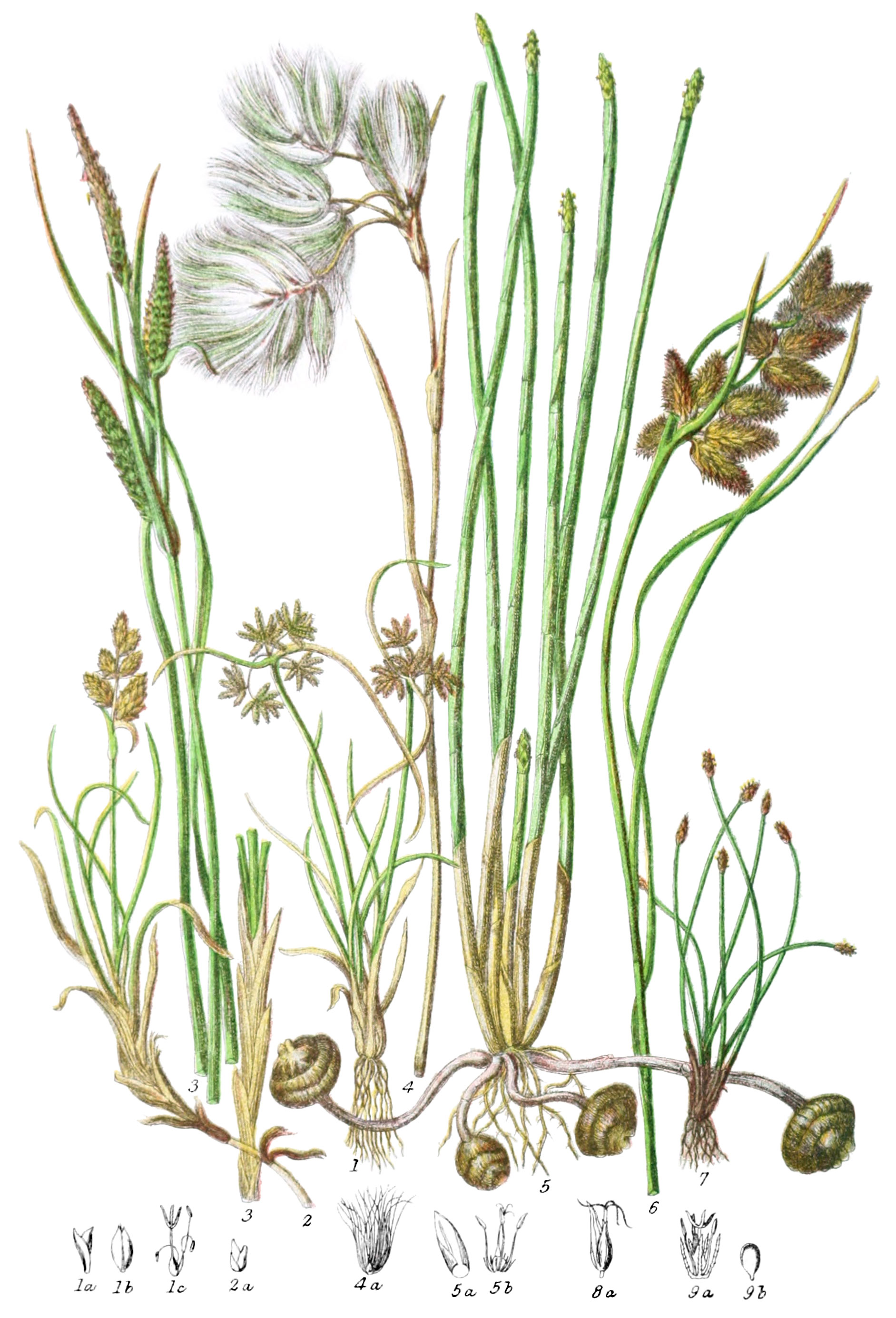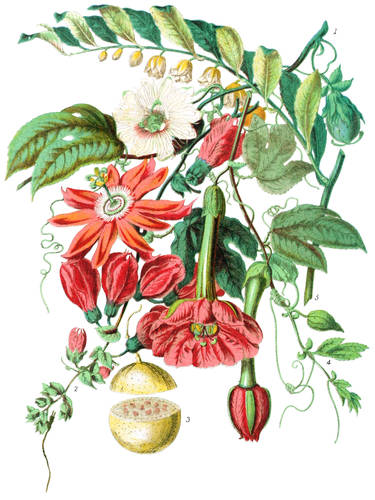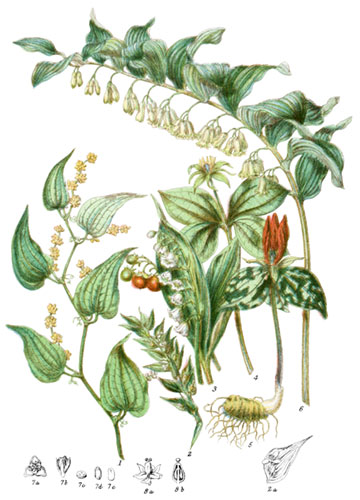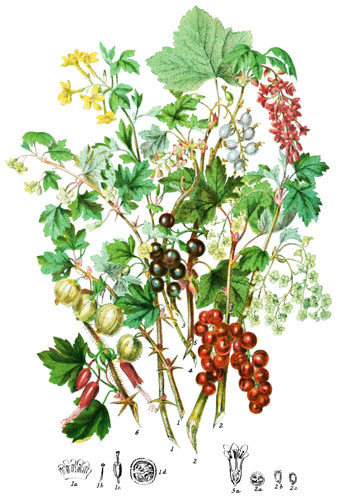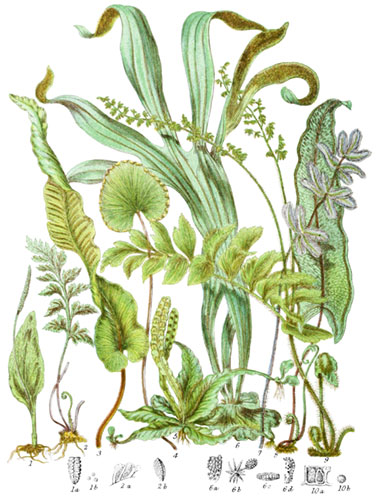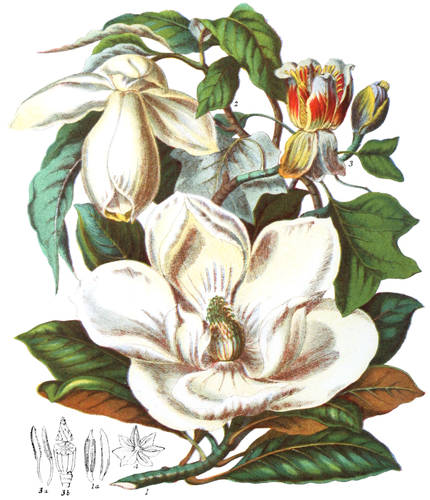Key characteristics
Herbaceous, grass-like plants, the stems of which are hollow, and seldom have partitions at the joints; frequently tubular, sometimes tuberous at the base. The leaves are narrow, and usually enclose the stem with a sheath which is never slit. The flowers; the stamens and pistil are often in separate flowers; the stamens are from one to twelve; the anthers fixed by their base; the style is single, bifid, or trifid; the stigmas are undivided, occasionally bifid. The fruit is a hard nut, with a single seed, containing fleshy or mealy albumen.
This Tribe has close affinity with grasses.
A wholesome mucilage is contained in the tubers of some of these plants.
Select plants in this order
Not all plants listed are illustrated and not all plants illustrated are listed.
- Cyperus is a genus inhabiting marshy, watery places, of few useful properties, though in former times of scarcity the roots of C. longus, the largest English species, and those of C. esculentus in France, where boiled and eaten by peasants. The latter is still known as Souchet comestible, and the roots from one of the ingredients of orgeat.
- C. fuscus (1) is a rare species in this country, more frequent on the Continent.
- C. longus, the Galingale, is seldom seen here now, only occasionally in Wales; the root is creeping, and has an aromatic flavour; the stem is two or three feet high, bearing a spreading panicle of shining spikes.
- C. bulbosus, of Malabar, has small tubers, where the natives cook and eat.
- C. Iria is known as a medicine in India; the roots of C. rotundus are also employed in Hindoo doctors.
- Indian ladies use the powdered roots of C. pertenuis to perfume their hair.
- The properties of these plants are of slight value, yet they appear among the most ancient remedies mentioned by Hippocrates and Theophrastus.
- The numerous species of Carex, like those of Cyperus, are usually found growing in wet places and bogs; a few inhabit shady moist woods, mingling their gracefully drooping spikes amongst the grasses and other plants. The larger species are more useful in other countries than here; the Laplanders prepare some to stuff garments for warmth, and in Italy they serve various purposes.
- The long penetrating roots of C. arenaria (2) bind the loose sand of the shores of the Solway Frith, and on the dyes of Holland this and other species are carefully cultivated for the sake of fixing the light soil, and giving strength to the embankments.
- C. stricta (3) is more upright than other nearly similar species; C. riparia has the widest leaves, still used for chairs in Italy, as once here.
- Eriophorum is peculiar to moors and bogs in northern countries; E. polystachion (4) has a remarkable appearance when the white silky tufts are seen waving over the moors of the Scotch Highlands, or the bogs of North Wales; in those barren and poor districts the down is sometimes collected for stuffing pillows.
- The leaves of E. cannabinum, of the Himalayas, are made into ropes by the natives.
- Scirpus derived its name from the Celts, who doubtless availed themselves of its valuable quantities in their domestic life.
- S. lacustris, the bulrush, was thought good formerly for thatching cottages, stuffing pack-saddles, and forming the seats of chairs.
- S. cœpitosus is still the chief food of cattle in the Highlands during the spring months.
- S. maritimus (6) is eaten readily by cattle in the marshes of Europe and Siberia.
- The Chinese esteem the tubers of S. tuberosus (5), and cultivate it in tanks in their gardens.
- Isolepis (7) is chiefly distinguished from Eleocharis by having no bristles under the ovary, and the style not being jointed at the base. It grows always in turfy bogs.
- The most celebrated plant of this tribe is Papyrus antiquorum of Egypt; out of a long horizontal root rises the triangular stem, from the inner layer of which the ancient Egyptians made their paper. The spreading umbel of flowers adorned their temples, and the stalks and leaves were formed into ropes and boats in the time of Pliny, as is still done in Abyssinia.
- Mariscus and Kyllingia both belong to the East Indies and Brazil; Fuirena to Australia and South America.
Locations
This Tribe inhabits marshes, ditches, streams, woods, dry sands, and lofty mountains in all parts of the world where vegetation exists. In Lapland it is as abundant as grasses, in the Tropics more rare. Scirpus belongs to Europe, South America, and Australia.
Legend
- Cyperus fuscus, Brown Cyperus. England.
- Outer Glumes.
- Inner.
- Stamens and Pistil.
- Carex arenaria, Sand Sedge. Shores, Britain.
- Glumes.
- Carex stricta, Straight Sedge. Marshes, Britain.
- Eriophorum polystachion, Broad-leaved Cotton-grass. Bogs, Britain.
- Seed and Down.
- Scirpus tuberosus. China.
- Glume.
- Flower.
- Scirpus maritimus, Saltmarsh Clubrush. England.
- Isolepis acicularis, Least Spike-rush. Bogs, England.
-
- Carex rivularis.
-
- Scirpus lacustris. Flower with Bristles.
- Seed.
Explore more
Posters
Decorate your walls with colorful detailed posters based on Elizabeth Twining’s beautiful two-volume set from 1868.
Puzzles
Challenge yourself or someone else to assemble a puzzle of all 160 botanical illustrations.
